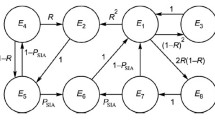Abstract
A model that describes the operation of a multi-element restorable system is constructed. After failure, each element of the system remains functionally operable due to an immediately refilled time redundancy. An element is considered to be failed if its restoration time exceeds the time redundancy. In this case, all elements that have a functional link with a failed element are not disconnected. All random variables describing the evolution of the system over time are assumed to have general distributions. This system is studied using the framework of semi-Markov processes with a discrete-continuous state space. The stationary distribution of the embedded Markov chain is found by solving the system of integral equations. Formulas for calculating the stationary availability and mean stationary sojourn times of the system in the operable and failure states are obtained. The stationary characteristics of the system are expressed through the stationary availabilities of its elements and the structural function of the system. An illustrative example of a 3-out-of-4 system is given, and its characteristics are calculated depending on different time redundancies of the elements.
Similar content being viewed by others
References
Polovko, A.M. and Gurov, S.V., Osnovy teorii nadezhnosti (Foundations of Reliability Theory), St. Petersburg: BKhV-Peterburg, 2006.
Ushakov, I., Is Reliability Theory Still Alive?, Reliab.: Theor. Appl., 2007, vol. 2, no. 1, pp. 6–19.
Kashtanov, V.A. and Medvedev, A.I., Teoriya nadezhnosti slozhnykh sistem (Reliability Theory of Complex Systems), Moscow: Evropeiskii Tsentr po Kachestvu, 2002.
Cherkesov, G.N., Nadezhnost’ apparatno-programmnykh kompleksov (Reliability of Hardware-Software Complexes), St. Petersburg: Piter, 2005.
Beichelt, F. and Franken, P., Zuverläassigkeit und Instanphaltung, mathematische Methoden, Berlin: VEB Verlag Technik, 1983.
Gnedenko, B.V., Belyaev, Yu.K., and Solov’ev, A.D., Matematicheskie metody v teorii nadezhnosti (Mathematical Methods in Reliability Theory), Moscow: Nauka, 1965.
Barlow, R. and Proschan, F., Mathematical Theory of Reliability, New York: Wiley, 1965.
Ushakov, I.A., Probabilistic Reliability Models, San Diego: Wiley, 2012.
Kredentser, B.P., Prognozirovanie nadezhnosti sistem s vremennoi izbytochnost’yu (Reliability Prediction for Systems with Time Redundancy), Kiev: Naukova Dumka, 1978.
Cherkesov, G.N., Nadezhnost’ tekhnicheskikh sistem s vremennoi izbytochnost’yu (Reliability of Technical Systems with Time Redundancy), Moscow: Sovetskoe Radio, 1974.
Kopp, V.Ya., Obzherin, Yu.E., and Peschansky, A.I., Stokhasticheskie modeli avtomatizirovannykh proizvodstvennykh sistem s vremennym rezervirovaniem (Stochastic Models of Computerized Manufacturing Systems with Time Reservation), Sevastopol: Sevastop. Natsion. Tekh. Univ., 2001.
Sennova, E.V., Smirnov, A.V., Ionin, A.A., et al., Nadezhnost’ sistem energetiki i ikh oborudovaniya (Reliability of Energy Systems and Their Equipment), Rudenko, Yu.N., Ed., Novosibirsk: Nauka, 2000, 4 vols.
Korolyuk, V.S. and Turbin, A.F., Protsessy markovskogo vosstanovleniya v zadachakh nadezhnosti sistem (Markovian Restoration Processes in System Reliability Problems), Kiev: Naukova Dumka, 1982.
Korlat, A.N., Kuznetsov, V.N., Novikov, M.I., et al., Polumarkovskie modeli vosstanavlivaemykh sistem i sistem massovogo obsluzhivaniya (Semi-Markov Models of Restorable Systems and Queueing Systems), Kishinev: Shtiintsa, 1991.
Obzherin, Yu.E. and Peschansky, A.I., Calendar Maintenance of Arbitrarily Structured Systems, Cybern. Syst. Anal., 2006, vol. 42, no. 2, pp. 219–233.
Peschansky, A.I., Stationary Characteristics of an Unreliable One-Server Queueing System with Losses and Immediately Refilled Time Reserve, Vestn. Samarsk. Gos. Tekh. Univ., Ser. Tekh. Nauk., 2018, no. 2 (58), pp. 36–46.
Obzherin, Yu.E. and Peschansky, A.I., Reliability Analysis of a System with Gradually Refilled Time Reserve, Cybern. Syst. Anal., 2001, vol. 37, no. 3, pp. 361–372.
Obzherin, Yu.E. and Peschansky, A.I., Reliability Analysis of a System with Combined Time Reserve, Cybern. Syst. Anal., 2004, vol. 40, no. 5, pp. 747–754.
Acknowledgments
This work was supported by the Ministry of Education and Science of the Russian Federation (state order no. 1.10513.2018/11.12) and by the Russian Foundation for Basic Research, project no. 19-01-00704.
Author information
Authors and Affiliations
Corresponding author
Additional information
This paper was recommended for publication by V.M. Vishnevskii, a member of the Editorial Board
Russian Text © The Author(s), 2019, published in Avtomatika i Telemekhanika, 2019, No. 12, pp. 146–159.
Rights and permissions
About this article
Cite this article
Peschansky, A.I. Semi-Markov Model of a Restorable System with Elementwise Time Redundancy. Autom Remote Control 80, 2206–2216 (2019). https://doi.org/10.1134/S0005117919120099
Received:
Revised:
Accepted:
Published:
Issue Date:
DOI: https://doi.org/10.1134/S0005117919120099




